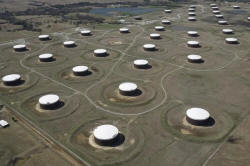|
Oil falls as market stays
well supplied despite cuts
 Send a link to a friend
Send a link to a friend
 [May 18, 2017]
By Christopher Johnson [May 18, 2017]
By Christopher Johnson
LONDON
(Reuters) - Oil prices fell on Thursday on signs that the market
remained well supplied with crude despite efforts by OPEC and other big
exporters to curb production and support prices.
Signs of a deepening political crisis in Washington accelerated the
decline in prices with investors becoming increasingly cautious
following the latest reports of links between Russia and the team in the
White House.
Brent crude fell $1.10 a barrel to a low of $51.11 and was trading
around $51.30 by 1050 GMT (6.50 a.m ET). U.S. crude oil was 84 cents a
barrel lower at $48.23.
Traders said news that the campaign to elect President Donald Trump last
year had at least 18 undisclosed contacts with Russians had unsettled
investors.
"Sentiment is fragile so it does not take much to rock the boat even
further," said Ole Hansen, head of commodity strategy at Denmark's Saxo
Bank. "This is a general risk-off move."
Both crude oil benchmarks rose on Wednesday after news of a drawdown in
U.S. crude inventories and a dip in U.S. output. The U.S. Energy
Information Administration said inventories fell 1.8 million
barrels in the week to May 12 to 520.8 million barrels.

But the U.S. crude drawdown was smaller than expected and the oil market
remained extremely well supplied, analysts said.
A surplus of U.S. supply has led to large volumes of crude being
exported from the United States to northern Asia, undermining the
OPEC-led efforts to tighten the market.
to top of second column] |

Crude oil storage tanks are seen from above at the Cushing oil hub,
in Cushing, Oklahoma, March 24, 2016. REUTERS/Nick Oxford/File Photo

The
Organization of the Petroleum Exporting Countries and other producers including
Russia pledged to cut output by almost 1.8 million barrels per day (bpd) in the
first half of 2016, a deal likely to be extended until the end of March 2018.
Other producers have been quick to fill any supply gaps.
Shipping data in Thomson Reuters Eikon shows that U.S. crude exports to Asia
have soared from a handful of tankers a quarter throughout 2015 and 2016 to 10
tankers in the first quarter of 2017 and that figure is expected to rise.
OPEC ministers meet in Vienna on May 25 to decide production policy for the next
six months and are expected to prolong their agreement to limit production,
perhaps by up to nine months.
UBS oil analyst Giovanni Staunovo said he saw a 60 percent probability of OPEC
extending output cuts. That should help tighten the oil market and push up
prices as demand rises gradually this year, he said.
(Additional reporting by Henning Gloystein; editing by David Clarke)
[© 2017 Thomson Reuters. All rights
reserved.] Copyright 2017 Reuters. All rights reserved. This material may not be published,
broadcast, rewritten or redistributed. |